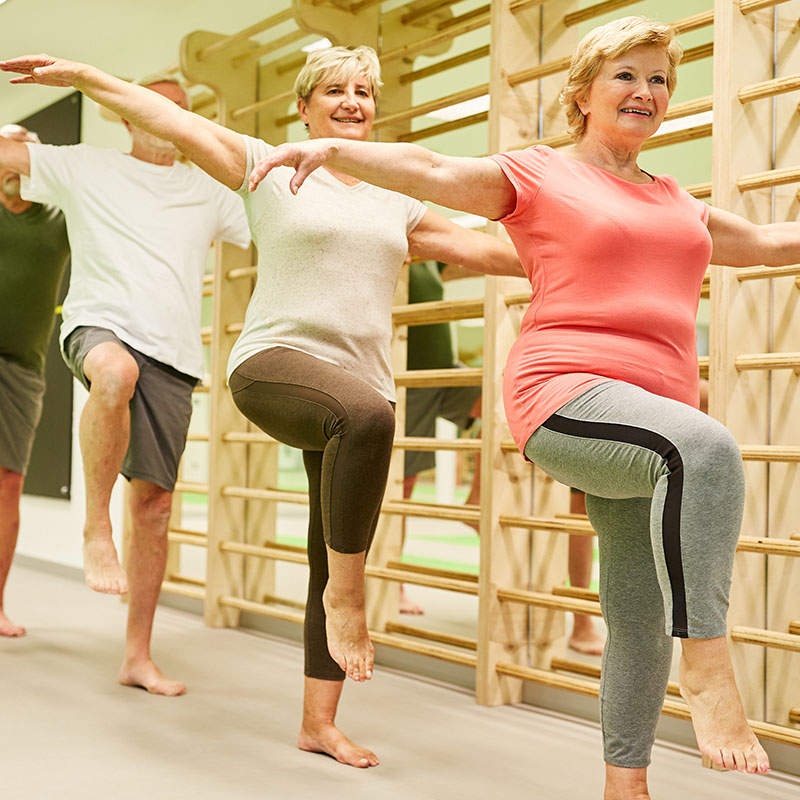Studies Show Simple Things Work To Improve Mobility And Reduce Your Risk Of Falling
It’s fall prevention month here at Optimum Wellness Centers! Losing muscle mass, decreased reaction time, and decreased sensation are all a natural part of the aging process. However, getting older DOES NOT mean that you cannot help prevent falls. Although accidents happen, you can actively improve your balance and help decrease your risk of falls in the home. Whether you noticed that you are more unsteady on your feet, have been recently hospitalized, or are generally deconditioned, there are steps that you can take to get better, and we are here to help.
Quick Facts:
- Deconditioning/ Disuse Disequilibrium is a non-vestibular cause of unsteadiness1
- It is known to happen to deconditioned individuals such as those who stop walking and exercising because of recent immobilization due to surgery, fatigue, chronic illness, or had an issue with falling.1
- When balance is not challenged regularly with physical activity, there can be a decreased automatic response with postural control for balance.1
- Lack of physical activity can lead to a progressive decline in muscle bulk, joint range of motion, and slower reflex time leading to disuse disequilibrium, which is especially seen in the elderly population.1
- Fear of falling can be associated with disuse disequilibrium as it can reduce the patient’s willingness to do physical activity, and it can affect therapy with the patient’s participation in a home exercise program.1,2,3
Age related changes in the body:

Medicare now recommends annual fall-risk assessments performed by a licensed physical therapist.
As we age, many of us will experience sarcopenia. Sarcopenia is the loss of muscle tissue, and can begin as early as 40 years old. Evidence suggests that muscle mass and strength both decline with up to 50% being lost by age 80. This is often associated with a loss of function, acute and chronic disease, increased insulin resistance, fatigue, falling, mortality and disability. Furthermore, Type II muscle fibers (fast twitch muscle fibers) are affected and turned to Type I muscle fibers (or slow twitch fibers). Instead of being able to react quickly, we act slowly to stimuli, as we have fewer fast twitch muscle fibers to react.4,5
As far as strength is concerned, most older adults who are sedentary demonstrate a 1% decline in strength at age 50, and a 3% decline in muscular strength at age 70. Older adults are the least physically active of all age groups with only 11% of individuals over the age of 65 reporting that they engage in aerobic and strengthening activities in compliance with ACSM recommendations. Finally, in individuals over the age of 65, about one third will fall this year.6
What does the Research say?
- In a Cochrane review for fall prevention, there was limited evidence to support any one exercise intervention. The review included 60 randomized controlled trials involving 60,345 participants, half of whom were in care facilities or in the hospital. Instead, smaller studies suggest that a daily home exercise program that increases endurance, balance, and lower extremity strength frequently resolves the problem. Success of the intervention is also dependent on compliance by the patient and support from the family or friends.2
- 12 weeks of strength training 2x/wk with intensity ranging from 30-80% 1RM, including explosive muscle actions, resulted in 14% of muscle cross section increases in older men and women helping to combat sarcopenia.8
- A study by Dohrn, Halvarsson, & Stahle (2015) investigated the effects of balance training on older adults. The training consisted of 45- minute sessions, 3 times a week over the course of 12 weeks. The training was conducted by physical therapists in a controlled gym setting utilizing various interventions including unstable surfaces and vision-eliminated challenges in both static and dynamic positionings. The results demonstrated improved balance control, improved fall-related self- efficacy, decreased fear of falling, and faster walking speed.7
- While this study supports balance training performed by a physical therapist, activities that challenge balance by changing the base of support such as yoga or tai chi would be beneficial to improving balance and decreasing fall risk in the older adult population.
- “Older adults and individuals with neurological conditions are at an increased risk for falls. Although physical exercise can prevent falls, certain types of exercise may be more effective. Perturbation-based balance training is a novel intervention involving repeated postural perturbations aiming to improve control of rapid balance reactions. The purpose of this study was to estimate the effect of perturbation-based balance training on falls in daily life. Eight studies involving 404 participants were included. Participants who completed perturbation-based balance training were less likely to report a fall (overall risk ratio=0.71; 95% confidence interval=0.52, 0.96; P=.02) and reported fewer falls than those in the control groups (overall rate ratio=0.54; 95% confidence interval=0.34, 0.85; P=.007). Conclusion: Perturbation-based balance training appears to reduce fall risk among older adults AND individuals with Parkinson disease.9”
References:
- Hall, C. and Heusel-Gillig, L. (2010). Balance rehabilitation and dual-task ability in older adults. Journal of Clinical Gerontology and Geriatrics, 1(1), pp.22-26.
- Herdman, S. and Clendaniel, R. (2014). Vestibular Rehabilitation. 4th ed. FA Davis, pp.409, 556-557.
- Greig, C. A., Botella, J., & Young, A. (1993). The quadriceps strength of healthy elderly people remeasured after eight years. Muscle & Nerve: Official Journal of the American Association of Electrodiagnostic Medicine, 16(1), 6-10.
- Williams, G., Higgins, M., Lewek, M. (2002); Aging Skeletal Muscle: Physiologic Changes and the Effects of Training, Physical Therapy, Volume 82, Issue 1, 1 January 2002, Pages 62–68, https://doi.org/10.1093/ptj/82.1.62
- Talbot, J., & Maves, L. (2016). Skeletal muscle fiber type: using insights from muscle developmental biology to dissect targets for susceptibility and resistance to muscle disease. Wiley Interdisciplinary Reviews. Developmental Biology, 5(4), 518–534. http://doi.org/10.1002/wdev.230
- ACSM Exercise Testing and Prescription (1st ed.). (2018). Philadelphia, PA: Wolters Kluwer
- Dohrn, I., Halvarsson, A., & Stahle, A. (2015). Taking balance training for older adults one step further: the rationale for and a description of a proven balance training programme. Clinical Rehabilitation, 29(5), 417-425.
- Cadore, E. L., Pinto, R. S., Bottaro, M., & Izquierdo, M. (2014). Strength and Endurance Training Prescription in Healthy and Frail Elderly. Aging and Disease, 5(3), 183–195. http://doi.org/10.14336/AD.2014.0500183
- Avril Mansfield, Jennifer S. Wong, Jessica Bryce, Svetlana Knorr, Kara K. Patterson, Does Perturbation-Based Balance Training Prevent Falls? Systematic Review and Meta-Analysis of Preliminary Randomized Controlled Trials, Physical Therapy, Volume 95, Issue 5, 1 May 2015, Pages 700–709, https://doi.org/10.2522/ptj.20140090


